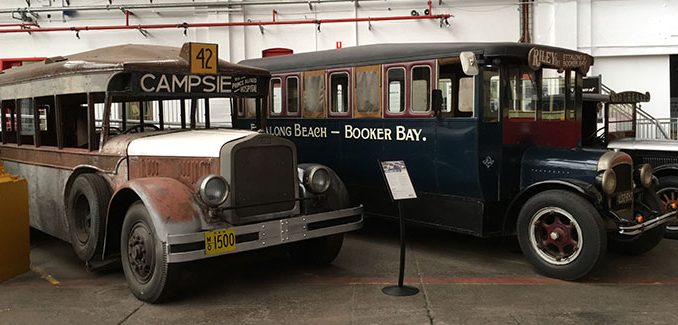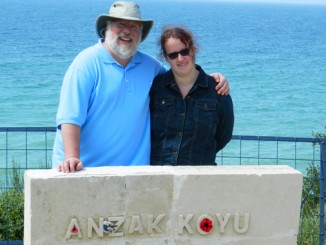
Charming vintage vehicles live on at the Sydney Bus Museum in Leichhardt
The polished double decker buses of Sydney’s bygone era don’t only exist in Harry Potter stories. Maria Zarro talks to volunteers Duncan MacAuslan and David Griffiths from the Sydney Bus Museum about its role in preserving the city’s public transport heritage.
The Sydney Bus Museum is shaping up to become the Inner West’s most exciting heritage space. A non-profit organisation run entirely by volunteers, it was established fifty years ago by the Historical Commercial Vehicle Association to preserve and maintain vehicles that represent Sydney’s public transport evolution. The collection includes over seventy items, mostly classic buses such as post-war Leylands, Albions, AEC Regents and Bedfords. A quirky Ruggles bus dates back to 1924, and a 1945 Ford FCB 194 ‘austerity bus’ forms part of the museum’s World War II exhibition. An extensive transport archive containing signage, photographs and other key artefacts is also on display.
Formerly located in Tempe, the museum opened to the public at Derbyshire Street in Leichhardt last August. “The current location is a traditional government building for trams and buses, so it’s a suitable home for these vehicles,” explains curator and board member Duncan MacAuslan. “It was originally a tramway depot and then a government bus workshop. As you can see, many of the original markings remain on the building’s floor.”
Indeed, there is something so gratifyingly old school about the Sydney Bus Museum that it feels like stepping inside a time machine and revisiting a simpler era. The last double-deckers graced Sydney’s roads in 1976 and were made redundant due to changing transport trends. Even though some of them went into private operation, the majority of vehicles were abandoned. Many of the buses housed in the museum and workshop were recovered from farmyards, paddocks, and residential backyards in regional areas. “It’s important to preserve these buses as part of our local history,” Duncan stresses, “because portions of the Inner West — Five Dock, Haberfield, Leichhardt and Rozelle, for example — do not have a public transport service other than buses.”
A dedicated voluntary workforce, made up of over 250 members, is responsible for the museum’s longevity and upkeep. Duncan emphasises the importance that teamwork plays amongst volunteers, who come equipped with a diversity of skills and strengths. Anyone can volunteer at the Sydney Bus Museum, not just Inner Westies. Female volunteers are encouraged to participate in meaningful ways, with many women holding positions in media and curatorial roles. Committed volunteer, Cindy Sun, is responsible for maintaining complex record-keeping accounts for the museum’s annual report. Formal mechanical skills aren’t always necessary for vehicle repair and maintenance, but knowledge, enthusiasm and a willingness to ‘muck-in’ are. “What is important is creating a positive environment and a strong sense of camaraderie,” says Duncan. “The most enjoyable days are the ones like Australia Day where we all get together at the end of the museum’s open day and go for a drink at the Orange Grove.”
Volunteers who do hold technical skills, such as David Griffiths, are highly valued because it means that most mechanical repairs can be completed onsite. “The buses need to be as roadworthy as any vehicle currently on Sydney’s roads on the days they operate for community and charitable events,” David explains. Nominated for the Highly Commended Senior Citizen of the Year award for his thirty-year effort with the Sydney Bus Museum, David has performed a variety of tasks: from administrative, library and subscription work to vehicle repair and solving complex mechanical issues. He has lead teams on restoration assignments and special projects such as the ‘Harry Potter bus’, which involved painting a double-decker purple for the Powerhouse Museum’s Harry Potter exhibition in 2011.
David’s prized bus, a handsome Leyland, lives in the museum and is popular with visitors, especially children. Discovered on a farm at Yeoval in the Central West region of New South Wales, he salvaged the rusted carcass and restored it to its original condition, making it one of the museum’s most valued pieces.
The museum’s star attraction is the vintage double-decker bus ride over the ANZAC bridge to the Queen Victoria Building. Open days held on Australia Day and the June long weekend are popular with young families keen on grabbing seats top deck to experience the ultimate sightseeing tour. Unsurprisingly, the double-decker is making a comeback as both a private and public transport service in some parts of Sydney, although there aren’t any plans to reintroduce it to the Inner West at this stage.
Both Duncan and David agree that these quirky, brightly painted buses bring out the best in volunteers and visitors alike. “It’s such an exhilarating thing to ride on a double-decker,” Duncan enthuses. “Children, mums, dads – everyone – they just love it!”
Sydney Bus Museum
Old Leichhardt Tramshed
25 Derbyshire Road
Leichhardt NSW 2040
ph: 9572 6789
web: www.sydneybusmuseum.info
Facebook: www.facebook.com/SydneyBusMuseum



